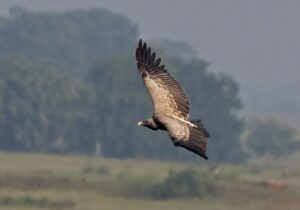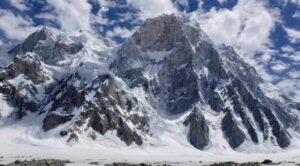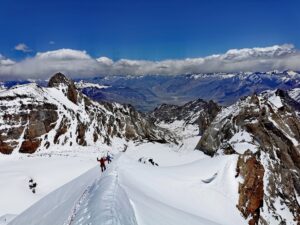Just when it seemed that no foreign expeditions would visit Pakistan this year, SummitClimb Europe Director and guide Felix Berg showed up in Gilgit to lead a small team to the little-known peaks of the Shimshal Valley. Two weeks later, in perfect weather, the climbers notched two first ascents. Call it coincidence, but soon after their trailbreaking journey, a handful of other climbers soon showed up in the same area.
Check the complete report, including climbing details, route topos and a cool image gallery here.
Back home in Germany, Berg spoke to ExplorersWeb about exploring Pakistan’s mountains in Eric Shipton’s style, the impact of the pandemic on local communities, climbers and guiding companies, the forecast for 2121 and his own perception of risk.
ExplorersWeb: Pakistan was actually Plan B, since your original goal was Khan Tengri. What happened?
Actually, Pakistan was Plan C. Originally, we had two groups slated for Khan Tengri, but eventually, the only local company in the area decided not to set up a Base Camp for the season. We then proposed climbing the mountain self-sufficiently, walking in and climbing alpine style. That put everyone off, except for some adventurous clients with a strong alpine background. Meanwhile, time went by, and Kyrgyzstan remained closed to foreigners, while Pakistan decided to open its borders. Hence, Plan C. It was only possible because the clients were so flexible.

Berg’s SummitClimb team.
ExWeb: You were probably the first foreign tourists in the country, arriving just a couple of days after it opened. How were the COVID and tourism situations?
I was quite surprised by how easily everything went, especially compared to my recent experience in Europe. I had just visited the Pyrenees and Chamonix and had to deal with crowds, traffic jams, some people not respecting social distance, etc.
Then I flew to Pakistan. Airports were empty, and everything was well organized: temperature controls everywhere, we left our addresses, stated where we were going, and received our visas efficiently on arrival. Then I took a domestic flight, with more safety measures that I had seen in Europe, including the flight attendant in a protective suit!
In Gilgit I did find other vsitors, because while the country had been closed to foreigners, some local tourists were enjoying the mountains.
ExWeb: Did you guys get tested just before going?
Sure. We didn’t need clean test results to enter Pakistan itself, but did need them to travel to the northern areas. We also had tests on our way home, after landing in Germany.
ExplorersWeb: Once the team gathered in Gilgit, how did you choose the peaks you’d climb?
During the planning, I suggested Shimshal, because for a long time I wanted to go to some less “standard” areas of Pakistan, rather than Baltoro and the 8,000’ers or Nanga Parbat. The Shimshal Valley seemed just ideal because of its large number of unclimbed peaks. I also knew that it had many smaller ones which were easy to reach. This suited us because we had planned a rather short trip of only three weeks. As for the specific peaks, I first contacted Mirza Ali, who was born in the area, and he sent us some pictures and ideas. However, once in Shimshal village, we discussed options, and in the end, we headed for a completely new area, just to look around.

One of the chosen peaks.
ExWeb: Sounds like a expedition out of the old days.
Yes, it was an amazing experience. It is definitely not something guided expeditions typically do, go and climb a new peak.
ExWeb: Indeed! Wasn’t uncertainty and the unknown terrain an issue among team members?
Surprisingly, it all went very well. Of course, we had rather adventurous climbers, who were focused not just on a summit but were ready to explore. During the climbs, we went light, alpine style, belaying when necessary, but the members also moved unroped a large part of the time. In fact, we did have an incident on our third climb when one slipped and fell about 60 metres, luckily with just minor injuries. And the way back to Gilgit was edgy because of the heavy rains. So, there was adventure all along the way.
ExWeb: Your weather while climbing seemed good, although late August is not popular in Pakistan. Was it just luck or could this stimulate future trips?
It was odd, because August is considered the rainiest season in Pakistan. But based on all my previous expeditions, it seems that every year is different. Sometimes it’s good in early June, sometimes August. It is really hard to predict, so we thought, why not give it a shot?
In our case, the weather in Pakistan was the best ever. On the way there, we didn’t have a single day of rain. When climbing, we had some minor systems one morning, but the rest was good.
But on the way out at the end of August, the forecast was good but the weather turned really bad. The two-day trek out and also the road trip from Shimshal to Gilgit were quite adventurous, with rocks falling on our car in the pouring rain and the drivers speeding as much as they could to get out before it got worse. We also had to leave the vehicle in places and walk on landslides which were still active, because it was raining non-stop. Then, on the Karakorum Highway, we had to walk several kilometres and changed course three times because of landslides.
ExWeb: Luckily, it all ended up well. Did you expect to bag two unclimbed peaks in such a short time?
I didn’t, because we headed for Pakistan with a single peak in mind, which we discarded during our discussion with Mirza Ali. We finally went to the other side of the valley, where there were more unclimbed peaks. The first one was relatively easy, the second ended up as quite a challenge, because the couloir was longer and steeper than it had seemed from below.
In particular, the final pitch was interesting: not too technical but hard to protect because of the mixed terrain and sketchy granite with loose snow on top. It was exposed but very rewarding to get to the top. It was also great to see the whole team successful: Gabriel Stroe, Patrik Münkel and also Markus Hohle, who had suffered that fall. Arshad Karim, a local climber, was a great help too and enjoyed himself. He mentioned how different this kind of climbing was from his past experiences on K2.
Mirza Ali helped with local organization and climbed the first peak with us. The locals we worked with were happy to have had a chance to work. In Shimshal, they depend on tourism. Although Shimshal isn’t as popular as the Baltoro, 20 to 30 trekking groups do Shimshal Pass in a normal year. This summer, however, we were the first and only group to hire local porters. Pakistan’s mountain communities are being hit hard. They do not have as much outside support as Nepal, where a number of NGOs operate.
The second half of the interview will appear tomorrow.






